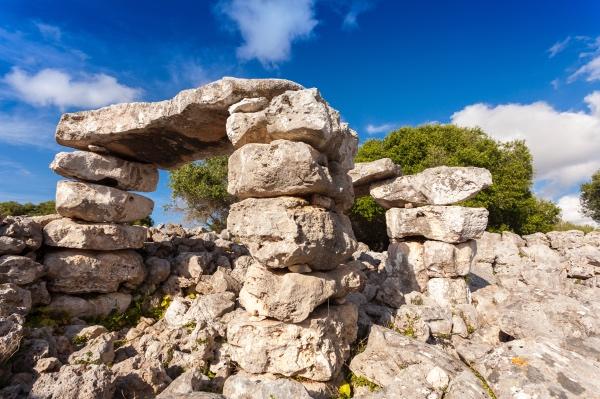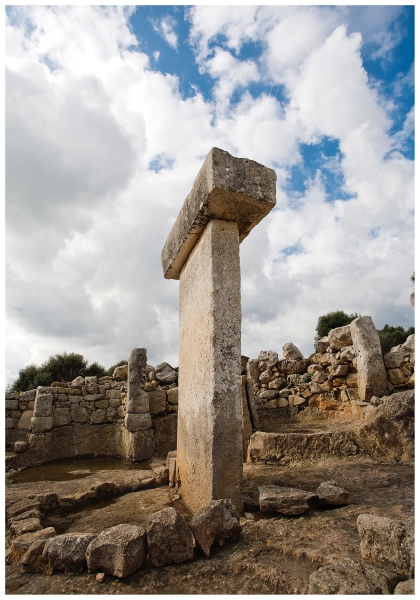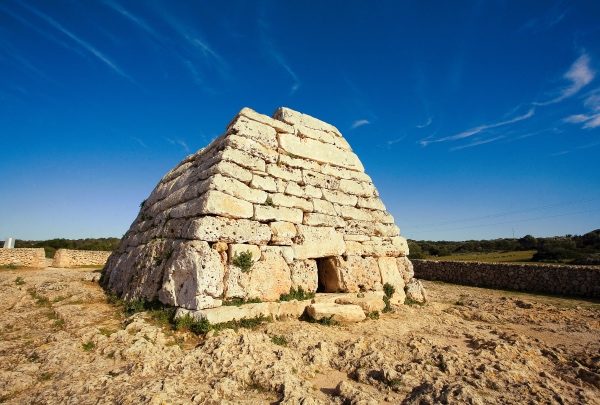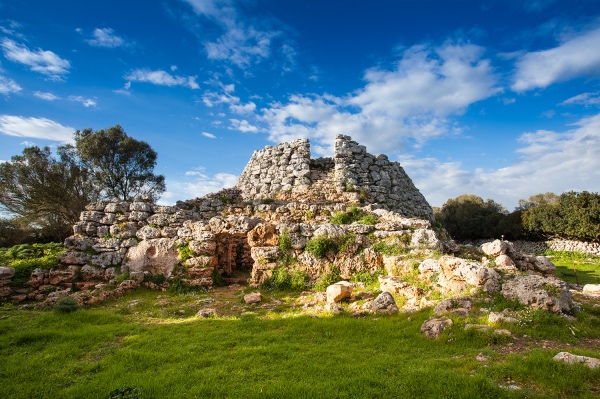 In accordance with Paragraph 77 of the Operational Guidelines for the Implementation of the World Heritage Convention, Talayotic Menorca meets Criteria (iii) and (iv).
In accordance with Paragraph 77 of the Operational Guidelines for the Implementation of the World Heritage Convention, Talayotic Menorca meets Criteria (iii) and (iv).
Criterion (iii) Bear a unique or at least exceptional testimony to a cultural tradition or to a civilisation which is living or which has disappeared.
The justification for criterion (iii) is based on the following features and dimensions inherent to the serial property:
a) Talayotic Menorca bears exceptional testimony to a Mediterranean island culture characterised by its spectacular cyclopean structures, which illustrate the human odyssey on small islands in prehistoric times.
b) The property attests to a remarkable process of cultural divergence in which a marked insularity was instrumental in enabling the island’s prehistoric inhabitants to shape and mould outside cultural influences over the course of centuries, developing a system of expressions unique to their island and its Mediterranean context. This idiosyncrasy ensured that their distinctive cultural traits survived across time and through all periods of their prehistory, unlike in other Mediterranean territories. The archaeological evidence reveals a society that was always deeply entrenched in its insularity and in its dogged defence of its endogenous expressions and beliefs, despite its relative contact with the outside world. This is attested to by the fact that they used money only for adornment, that they did not adopt writing and that they never used the potter’s wheel until their culture declined with the advent of the Roman Era.
c) Many of the attributes identified in the component parts of the property clearly bear witness to the creativity and intelligence of the prehistoric societies of the island that were capable of building authentic and original structures in their Mediterranean context. Collectively, they are an outstanding example of the ability of island cultures to create unique monuments found nowhere else.
d) The serial property contains a significant sample of the high diversity and density of prehistoric archaeological sites that have survived on the island of Menorca, many of which are remarkably well preserved. It is one of the highest densities recorded in the world in an extensive inhabited area, with 1,586 catalogued prehistoric sites in a mere 702 km2; within the boundaries of the nominated property, this density of sites attains unusually high levels. These sites are an exceptional repository of information on the physical features and way of life of the human communities that inhabited the island. They also provide an excellent vantage point from which to explore the traces left by the prehistoric civilisations. The property thus comprises one of the largest, most abundant, and most important prehistoric archaeological settings in the Mediterranean and the islands of the world.
 "A past that has remained alive in all the presents that comprise the history of the island"
"A past that has remained alive in all the presents that comprise the history of the island"
e) The remarkable legacy of Talayotic Menorca attests to a process of human occupation and adaptation to a confined territory in prehistoric times, under extreme conditions and with scarce resources, adopting a broad range of solutions to overcome the challenges of insularity. Against this background, each of the component parts of the serial property delimits a space that clearly illustrates the unique modes of adaptation and spatial organisation that characterised this culture, including the patterns that defined the territorial duality between the world of the living and the world of the dead. Each space is physically interconnected and the intervisibility relationships between settlements and representative monuments are clearly discernible. As such, the property is an outstanding example of archaeological sites in which it is possible to interpret and reveal the universe of visual, symbolic, ecological and spatial relationships that sustained the life of prehistoric communities.
f) The property gives us an insight into a culture that had a robust relationship with the skyscape, as reflected in the design of certain monuments that are clearly interconnected with the sky. A number of cyclopean monuments and their megalithic predecessors, including the dolmens or megalithic tombs, the burial navetas and the taula enclosures, exhibit regular and stable orientation patterns over time, distinguishing them from other contemporaneous cultures with similar cyclopean features, making them outstanding attributes that may be considered unique expressions of cultural astronomy.
g) The recognition and permanence of the works of this culture throughout the centuries is a defining feature of the property. Many of the most representative monuments of Menorca’s prehistory have coexisted harmoniously with all the historical milestones of the island and its inhabitants, revealing a past that has remained alive in all the moments that have shaped the island’s history. The cultural and spiritual traces of the ancient settlers have survived on this land, not only through the tangible manifestations of their heritage, but also embedded in the toponyms, myths and legends, the stone tradition, the perception of the landscape and the very identity of the island throughout its history.
Criterion (iv) Be an outstanding example of a type of building, architectural or technological ensemble or landscape which illustrates (a) significant stage(s) in human history.
 To be an outstanding example of a type of building, architectural or technological ensemble or landscape which illustrates (a) significant stage(s) in human history.
To be an outstanding example of a type of building, architectural or technological ensemble or landscape which illustrates (a) significant stage(s) in human history.
The justification for criterion (iv) is based on the following dimensions which characterise the buildings and associated landscapes represented in the serial property:
a) The component parts of the property contain an exceptional array of works that clearly illustrate the different stages of the island’s prehistory, starting with the advent of cyclopean architecture, and display the full diversity of building typologies – including social, religious, funerary, dwelling and symbolic structures. The ensemble of monuments and sites forms one of the most complete manifestations of this type of building, in terms of diversity and functionality, in the prehistoric panorama of island territories in the Mediterranean and in the world.
b) The cyclopean structures, particularly the major monuments like the talayots, bear witness to the colossal undertakings of these human communities, bearing in mind the population numbers and the limited technical resources available. The property contains the most representative sample of the many talayots found scattered across the island, revealing the enormous quantity of stone required for their construction. The enormous collective effort involved in the construction of these unique buildings, and their social use, attest to their role as a unifying frame of reference for the ancient communities of the island, and demonstrate a firm intention to monumentalise the island territory.
c) The property bears witness to the sustained creative capacity of that culture to devise outstanding works which, in comparative terms, are unique and exclusive to this island. The most notable of these monuments are the burial navetas, the taula enclosures and the monumental circular houses. They are buildings that display a high level of architectural complexity which, as in the case of the taula enclosures, demonstrates an awareness of specific knowledge of physics, geology, and astronomy, as well as a close relationship with the skyscape. In addition, there are the unique morphological features of the towers or talayots, which are very different from their Mallorcan counterparts and are not comparable with any other turriform structures in the Mediterranean, and which also weave a complex web of intervisibility. Other notable features are the necropolises on cliffs and in ravines – unique in their location patterns – and the burial navetas.
d) The use of materials and resources during the prehistory of Menorca reveals a distinctive character, often sheltered from outside influences; this character may also be found in many of the manifestations of material culture. Unique and authentic works include the water catchment systems and cisterns found in the Talayotic settlements, exemplifying one of the most remarkable water supply systems in island prehistory. The property also boasts an archaeological marvel: an outstanding case of a prehistoric copper mine, one of the few mines excavated in southern Europe that have not been used since.
 “For archaeologists, Islands that are off the main routes are of the greatest importance. On a continent, or on large islands, there has always been waves of people, villages are built that then fall into neglect; civilisations emerge that later collapse and the ancient remains are often destroyed. On the fortunate islands as Menorca, somewhat off the beaten track, is where the best treasures of the past can be found.”
“For archaeologists, Islands that are off the main routes are of the greatest importance. On a continent, or on large islands, there has always been waves of people, villages are built that then fall into neglect; civilisations emerge that later collapse and the ancient remains are often destroyed. On the fortunate islands as Menorca, somewhat off the beaten track, is where the best treasures of the past can be found.”
Margaret A. Murray -1949
e) Each of the component parts of the serial property are examples of archaeological ensembles that are exceptionally well integrated into the living rural landscape of the present. As such, the prehistoric remains give shape to an outstanding monumental and archaeological landscape, in which they can be seen, interpreted, and explained. In these landscapes, successive historical stone cultures have overlapped to create agricultural spaces comprising a multitude of plots bounded by thousands of kilometres of dry stone walls and unique associated structures built using the same technique. This magnificent ensemble is built with the same materials that were used in the past and encloses the various archaeological sites without altering them, creating a unique symbiotic relationship that keeps the ancestral spirit of place alive.
f) The various component parts of the serial property, which include the most representative monuments of the Talayotic culture of Menorca, clearly show landscape continuity from prehistoric times to the present day. In addition to the well-preserved natural spaces, the rest of the area of the property is sustained by the distinctive Menorcan agroecosystem, defined by a landscape mosaic that is similar in many respects to the landscape that the ancient settlers helped to create from the middle of the second millennium BC. The serial property is therefore an outstanding ensemble of archaeological sites that can be situated in their context and appreciated in their landscape setting.